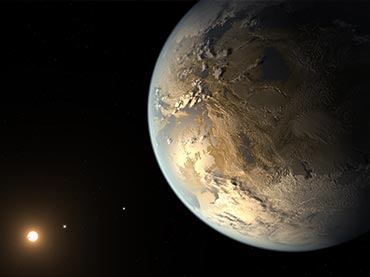An exoplanet, or extrasolar planet, is a planet that orbits a star other than the Sun. There are nearly 2,000 planets discovered and here are just a few strange ones for you to marvel at.
The Impossible Planet (Kepler-78b)
Kepler-78b sits about 400 light years away from Earth and orbits around its sun at a distance of approximately 550,000 miles. Considering the age and the type of the star it orbits, this impossible planet would need to form inside its sun to be at the orbit it’s in now as its sun had shrunk through the ages. Although only slightly larger than Earth in size, it has a surface temperature of over 2,000 degrees Fahrenheit, and it orbits its sun every 8.5 hours.

Blacker than Black (TrES-2b)
What could be blacker than black? TrES-2b, an exoplanet about 750 light years away from our solar system. This supergiant reflects less than 1 percent of sunlight and almost rightfully depicts what it is like to be in hell. Yet from space, the planet still shows some faint streaks of dark and dull red, the color of superheated gases in this planet’s upper atmosphere. TrES-2b has a hellish atmospheric temperature of about 1,800 degrees Fahrenheit, twice the temperature of Venus, which is also as hellish as Hades. This revolves around its sun for only 3 million miles.

Pulsarville (PSR 1257+12 b, c, d)
This trio of planets were the first exoplanets to be discovered 25 years ago. They give off so much radiation that it can blow away atmospheres, and from the radiation it produces, it can give off lightshows in the form of aurorae. The foundation of this pulsar is a neuron star, a super-dense fragment of a star left over after a nova or supernova.

Deathworld (HD 189773b)
Located 63 light years from Earth, HD 189773b is distinctly known for being the only discovered exoplanet whose real color is known, azure blue. Though pleasing to look at, it is still uninhabitable to human life. Its blue color comes from light reflected from particles of silicate, a key compound found in quartz, sand, and glass in the atmosphere. These particles form into glass shards that revolve around the planet, carried by winds at speeds of up to 4,000 miles per hour. Its atmosphere’s temperature is around 2,000 degrees Fahrenheit.

[adsense]
Warring Siblings (Kepler-36b and Kepler 36c)
This duo is composed of a larger planet and a smaller planet that revolve around each other as they orbit their sun. When they get to as close as a million miles from each other, the larger planet causes tidal forces to create eathquakes, volcanic eruptions, and firestorms on the smaller one. Only when they move from each other does calm exist. When their orbital paths cross once again every 97 days does the chaos return and start another cycle of destruction. The situation has been like this for Kepler-36b and Kepler-36c for many millenia as both are located in a solar system about 1,200 light years away from Earth. The larger planet is a rocky planet that is 1.5 times the size of Earth, while the smaller planet is a gas giant about the size of Neptune.

Diamond Planet (55 Cancri e)
The 55 Cancri e used to be an unsolved puzzle to the astronomers who first discovered it. It is only twice the size, eight times in weight, and twice Earth’s density, and is 40 light years away. The planet was thought to be a very carbon-rich star that looks like one large diamond due to its planet’s high temperature and high gravity conditions. But it has been observed that probably a sizable layer of diamond surrounding a small, rocky one.

Fireice (Gliese 436 b)
Gliese 436 b, about 33 light years from Earth, is completely covered in ice. But it also has a constant temperature of about 800 degrees Fahrenheit, more than the boiling point of water. The ice covering the planet is called ice ten, which exists despite the high temperature due to the Neptune-sized planet’s gravity. Gliese 436 is enveloped with hydrogen and helium with water vapor underneath it, which is compressed into a thick sheet of ice.



